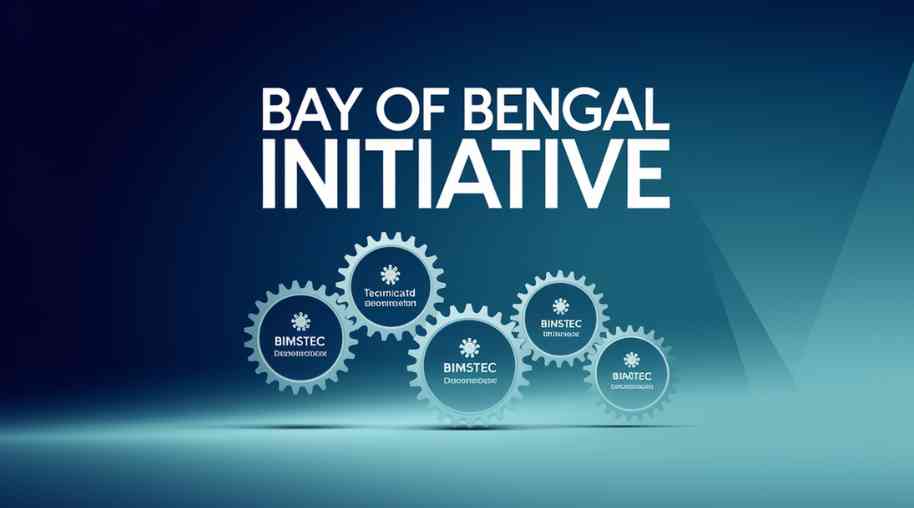BIMSTEC Full Form - Bay of Bengal Initiative for Multi Sectoral Technical and Economic Cooperation
by Shashi Gaherwar
0 1626
Bay of Bengal Initiative for Multi-Sectoral Technical and Economic Cooperation (BIMSTEC): Strengthening Regional Integration
Introduction
The Bay of Bengal Initiative for Multi-Sectoral Technical and Economic Cooperation (BIMSTEC) is a regional organization that brings together South Asian and Southeast Asian countries to promote economic cooperation, trade, and regional connectivity. Established in 1997, BIMSTEC has emerged as an important platform for fostering collaboration in multiple sectors, including trade, technology, energy, and security.

Member Countries
BIMSTEC comprises seven member countries:
- Bangladesh
- India
- Myanmar
- Sri Lanka
- Thailand
- Nepal
- Bhutan
These countries share strong geographical, historical, and economic connections, making BIMSTEC a crucial initiative for regional development.
Objectives of BIMSTEC
The primary goals of BIMSTEC are:
- Enhancing regional trade and investment
- Strengthening economic cooperation
- Improving connectivity through infrastructure development
- Promoting sustainable development and poverty alleviation
- Advancing technological collaboration
- Ensuring regional security and counter-terrorism efforts
Key Sectors of Cooperation
BIMSTEC focuses on 14 priority sectors, each led by a member country:
- Trade & Investment (Bangladesh)
- Transport & Communication (India)
- Energy (Myanmar)
- Tourism (India)
- Agriculture (Myanmar)
- Technology (Sri Lanka)
- Fisheries (Thailand)
- Counter-Terrorism & Transnational Crime (India)
- Environment & Disaster Management (India)
- Public Health (Thailand)
- People-to-People Contact (Thailand)
- Poverty Alleviation (Nepal)
- Cultural Cooperation (Bhutan)
- Climate Change (Bangladesh)
Achievements of BIMSTEC
Key achievements include:
- BIMSTEC Free Trade Agreement (FTA): A proposed FTA aims to boost intra-regional trade.
- BIMSTEC Energy Grid: An initiative to enhance energy security and cross-border power trading.
- BIMSTEC Transport Connectivity Master Plan: Infrastructure projects to improve regional connectivity.
- BIMSTEC Disaster Management Centre: Strengthening disaster preparedness and response capabilities.
- Security Cooperation: Efforts to combat terrorism, drug trafficking, and cyber threats.
Challenges and Roadblocks
Despite its potential, BIMSTEC faces several challenges:
- Slow Progress: Implementation of agreements and projects has been sluggish.
- Geopolitical Issues: Conflicting national interests among member countries.
- Funding Constraints: Limited financial resources for infrastructure and connectivity projects.
- Dependence on Bilateral Relations: Individual country dynamics often overshadow regional cooperation.
Future Prospects
To strengthen its role, BIMSTEC should focus on:
- Accelerating the BIMSTEC FTA to enhance trade and investment.
- Enhancing digital connectivity for smoother communication and business operations.
- Strengthening institutional frameworks to improve coordination among members.
- Increasing private sector participation in infrastructure and economic projects.
- Deepening cooperation in climate change mitigation and sustainable development.
BIMSTEC holds immense potential as a bridge between South Asia and Southeast Asia. By addressing its challenges and reinforcing cooperation, BIMSTEC can play a crucial role in economic growth, regional integration, and sustainable development for its member nations.
Further Learning Resources
If you’re passionate about building a successful blogging website, check out this helpful guide at Coding Tag – How to Start a Successful Blog. It offers practical steps and expert tips to kickstart your blogging journey!
For dedicated UPSC exam preparation, we highly recommend visiting www.iasmania.com. It offers well-structured resources, current affairs, and subject-wise notes tailored specifically for aspirants. Start your journey today!

Share:








Comments
Waiting for your comments